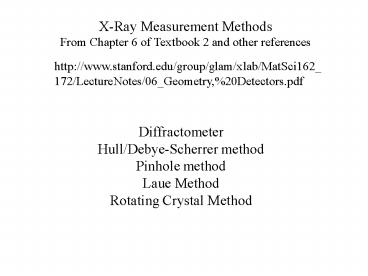X-Ray Measurement Methods - PowerPoint PPT Presentation
Title:
X-Ray Measurement Methods
Description:
... the angles in the same segment of a circle are equal to one another and the angle at the center of a circle is double that of ... on the same arc ... – PowerPoint PPT presentation
Number of Views:91
Avg rating:3.0/5.0
Title: X-Ray Measurement Methods
1
X-Ray Measurement Methods From Chapter 6 of
Textbook 2 and other references
http//www.stanford.edu/group/glam/xlab/MatSci162_
172/LectureNotes/06_Geometry,20Detectors.pdf
Diffractometer Hull/Debye-Scherrer method Pinhole
method Laue Method Rotating Crystal Method
2
Schematics of a typical X-ray diffractometer
S source C specimen H goniometer O
rotation axis A, B slits for collimation F
slit G detector E and H can be mechanically
coupled ? 2? and ? relation
3
focusing monochromator
CM 2R, OC R Cut off the crystal behind the
dotted line to a radius R
4
http//cheiron2008.spring8.or.jp/lec_text/Sep.30/2
008_T.Matsushita_1.pdf
5
http//cheiron2008.spring8.or.jp/lec_text/Sep.30/2
008_T.Matsushita_1.pdf
6
(No Transcript)
7
(No Transcript)
8
(No Transcript)
9
(No Transcript)
10
(No Transcript)
11
X-ray Optics
According to Euclid the angles in the same
segment of a circle are equal to one another and
the angle at the center of a circle is double
that of the angle at the circumference on the
same base, that is, on the same arc.
Bragg-Brentano diffractometers
12
Modern Bragg-Brentano laboratory diffractometer
13
Parallel beam geometry in Debye-Scherrer mode
using a double monochromator (DM) and an analyzer
crystal
14
Single crystal
Polycrystal
15
An ideal powder sample many crystallites in
random orientations smooth and constant
distribution of orientations Crystallites lt 10 µm
Sample preparation There are many methods
of preparing samples Sample should
normally be ground to lt 10 µm Sample may
be sieved to avoid large or small
crystallites Sample may be loaded into a
holder by pressing from the back while
using a slightly rough surface at the
front Sample may be pressed in from the
front Sample may be mixed with a binder
(epoxy or similar material) and then cut
and polished to give a suitable surface
16
Hull/Debye-Scherrer method
Film
Film
2?S/R
S
2?
2?
S
R
17
Film
Film
hole
S
S
2?
S
S
R
hole
2?
2?
2?
2?
2S
18
Film
hole
S
2?
R
2?
2?
2?
and
Resolving power
19
http//www.stanford.edu/group/glam/xlab/MatSci162_
172/LectureNotes/06_Geometry,20Detectors.pdf
20
Pinhole photographs
D
D
F
F
2q
Incident X-Ray
A
C
A
r1
C
r2
S
B
B
180o-2q
tan2q r1/D
tan(180o-2q) r2/D
monochromatic or white radiation and powder
sample Laue methode white radiation and single
crystal
21
Rotating Crystal Method
http//202.141.40.218/wiki/index.php/Unit-2_Intro
duction_to_X-ray_diffraction
22
(No Transcript)
23
Concept of Ewald Sphere and Diffraction
24
Wavelength incident beam diffracted
beam Magnitude of k ? the same 1/?.
Diffraction condition ?k G
?k? G?
?k G
2??B
2?B
25
(No Transcript)
26
Diffraction Methods
Method ?
? Laue Variable
fixed Rotating crystal Fixed
Variable Powder Fixed
Variable
? vaied ? reciprocal lattice isrotated or
Ewald sphere is rotated
27
Reciprocal lattice of polycrystalline sample
28
Features of Rigaku TTRAX?
29
(No Transcript)
30
(No Transcript)
31
(No Transcript)
32
(No Transcript)
33
(No Transcript)
34
(No Transcript)
35
(No Transcript)
36
(No Transcript)































